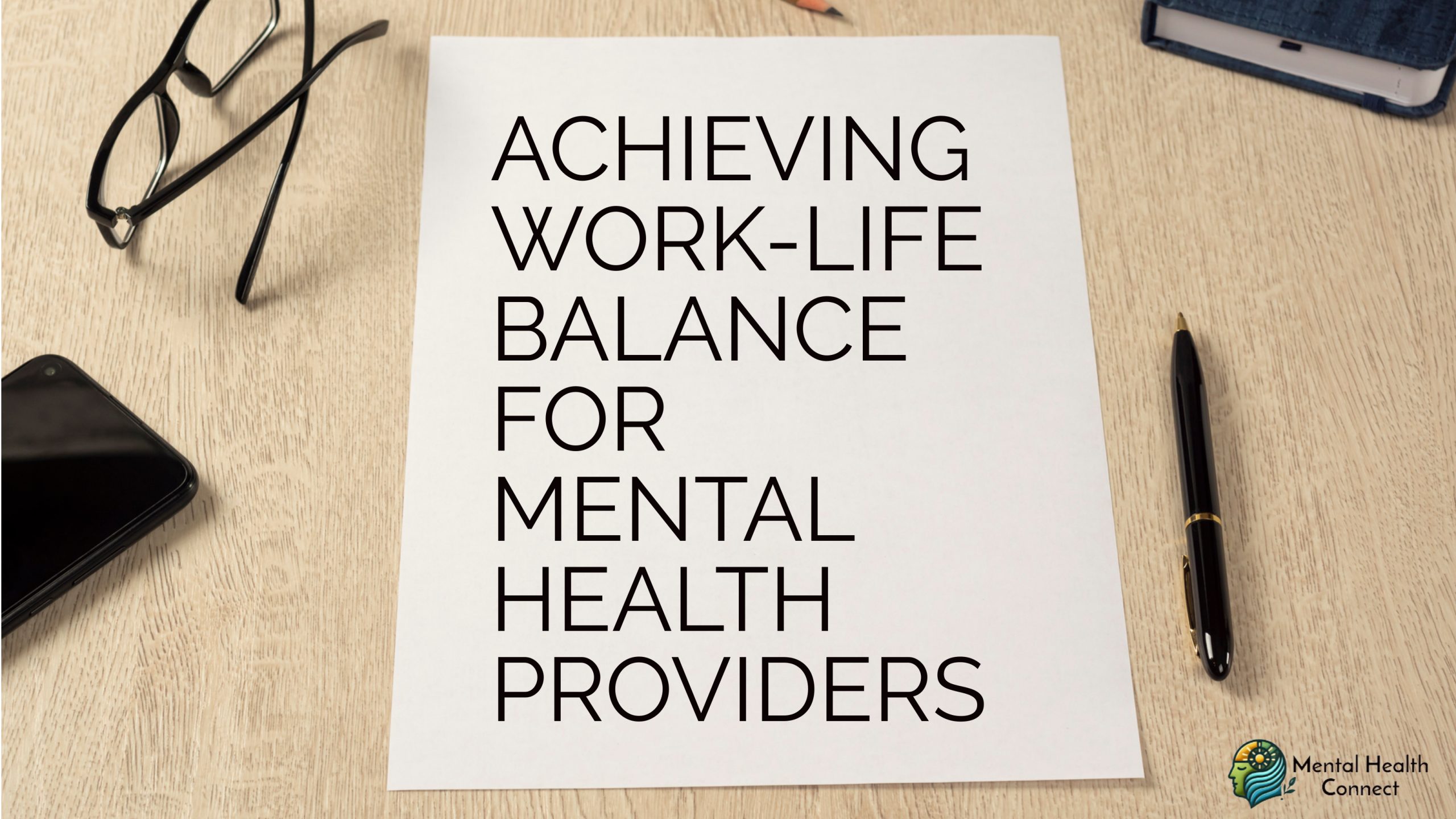Achieving Work-Life Balance for Mental Health Providers: Strategies That Actually Work

In a profession dedicated to healing others, mental health providers often find themselves struggling with their own emotional well-being. Work-life balance for mental health providers presents unique challenges in a field where empathic engagement is essential, but boundaries are easily blurred. Therapists, counselors, psychologists, and psychiatrists routinely absorb others’ traumas and emotional pain while managing demanding schedules, documentation requirements, and the pressure of holding space for vulnerable individuals. This constant emotional labor, combined with administrative burdens and ethical responsibilities, creates a perfect storm that can lead to compassion fatigue, burnout, and diminished effectiveness. Understanding how to establish and maintain healthy boundaries between professional responsibilities and personal needs is not just beneficial it’s essential for sustainable practice.
What is Work-Life Balance for Mental Health Providers?

Work-life balance for mental health providers refers to the equilibrium between professional responsibilities and personal well-being. Unlike in many other professions, this balance includes unique elements:
Emotional Boundary Management: Separating clients’ emotional needs from personal emotional reserves
Schedule Flexibility vs. Availability: Creating sustainable clinical hours while remaining accessible to clients in need
Documentation-Clinical Time Ratio: Balancing direct service with required paperwork and administrative tasks
Professional Development vs. Rest: Meeting continuing education requirements while ensuring adequate personal downtime
Vicarious Trauma Management: Processing secondary trauma exposure without carrying it into personal life
The Unique Challenges Mental Health Providers Face

Mental health professionals encounter distinctive barriers to work-life balance:
Emotional Labor: The core work requires sustained empathic engagement
Ethical Constraints: Confidentiality limits ability to process work experiences with personal supports
Crisis Management: Unpredictable client emergencies that disrupt personal boundaries
High Stakes Decisions: Carrying responsibility for clients’ safety and well-being
Limited Resources: Often working in understaffed settings with inadequate support
Why is Work-Life Balance Important for Mental Health Providers?

Professional Effectiveness
Research consistently shows that therapists experiencing burnout demonstrate:
Reduced empathic capacity
Diminished clinical judgment
Increased risk of ethical violations
Higher rates of documentation errors
Shortened career longevity
Personal Well-being Impact
Without adequate balance, mental health providers experience:
Higher rates of depression and anxiety
Increased substance use
Relationship difficulties
Physical health consequences
Compassion fatigue and vicarious traumatization
How to Achieve Work-Life Balance as a Mental Health Provider
Step 1: Conduct a Professional Energy Audit
Track activities that deplete versus energize you professionally
Identify client populations or presenting issues that create heightened stress
Monitor administrative tasks that consume disproportionate time
Note personal warning signs of approaching burnout
Assess current coping strategies’ effectiveness
Step 2: Establish Clear Boundaries
Define work hours and clinical availability with concrete start/end times
Create communication policies regarding after-hours contact
Develop protocols for managing crisis situations
Designate physical transitions between work and personal spaces
Implement technology boundaries (separate work/personal devices when possible)
Step 3: Optimize Clinical Schedule
Batch similar client concerns when possible to reduce emotional switching
Build in documentation time between sessions
Schedule challenging cases at your peak energy times
Create buffer days or half-days for administrative tasks
Limit consecutive days of high-intensity clinical work
Step 4: Develop Sustainable Self-Care Practices
Identify practices that genuinely replenish rather than just distract
Schedule self-care activities with the same commitment as client appointments
Build brief restoration breaks throughout the workday
Create clear “shutdown rituals” to transition from professional to personal life
Regularly reassess and adjust self-care strategies as needs change
Step 5: Build Professional Support Systems
Engage in regular clinical supervision or consultation
Join peer support groups specifically for mental health professionals
Consider your own therapy as both personal development and professional enhancement
Cultivate colleagues with whom you can process clinical challenges
Explore professional associations that advocate for sustainable practice
Best Practices for Work-Life Balance for Mental Health Providers

Intentional Practice Design
Determine ideal client load based on your specific circumstances and capacity
Create diversity in caseload to prevent emotional monotony
Develop specialized niches that energize your clinical interest
Consider practice models that support balance (group practice, part-time, telehealth options)
Regularly reassess fee structures to ensure financial sustainability without overworking.
Financial Planning for Sustainability
- Build emergency funds to allow for reduced caseload when needed
- Explore diverse income streams beyond direct clinical hours
- Consider fee structures that reflect the true value of your expertise
- Budget for regular vacation time and sabbaticals
- Plan for retirement with realistic projections about career longevity
Physical Workspace Optimization
- Create a clinical environment that supports your well-being
- Design ergonomic setups that reduce physical strain
- Consider natural lighting and elements that restore focus
- Ensure clear separation between clinical and personal spaces
- Incorporate movement opportunities throughout the workday
Common Mistakes in Achieving Work-Life Balance & How to Avoid Them
Mistake #1: Equating Self-Care with Indulgence
Many providers feel guilty prioritizing their needs. Instead:
- Reframe self-care as ethical professional responsibility
- Recognize that client outcomes improve with provider well-being
- Implement small, regular restorative practices rather than postponing until burnout
Mistake #2: Failing to Account for Emotional Labor
Mental health work requires emotional resources beyond time. To address:
- Calculate schedule based on emotional capacity, not just hours
- Build in processing time between emotionally challenging sessions
- Create “emotional decompression” routines after difficult clinical days
Mistake #3: Rigid Adherence to Traditional Practice Models
Many providers follow conventional practice patterns that don’t serve them. Instead:
- Question assumptions about clinical scheduling norms
- Explore innovative practice models (intensive retreats, group formats, telehealth)
- Design practice structure around personal strengths and life circumstances
Mistake #4: Postponing Boundaries Until Crisis
Setting limits only when overwhelmed is ineffective. Better approaches:
- Implement preventative boundaries before feeling depleted
- Establish clear policies at practice outset rather than retroactively
- Communicate limits as standard professional protocol rather than personal preference
Mistake #5: Isolating from Professional Community
Solo practitioners especially risk professional isolation. Instead:
- Proactively schedule regular peer consultation
- Join professional groups focused on sustainable practice
- Participate in supervision even when not required
- Consider shared office space to facilitate collegial connection
Future Trends in Work-Life Balance for Mental Health Providers
Technology Integration
- AI-assisted documentation reducing administrative burden
- Virtual reality tools for provider restoration between sessions
- Advanced scheduling algorithms optimizing clinical flow
- Telehealth innovations creating location flexibility
- Digital boundaries management tools
Practice Model Evolution
- Increase in collaborative care approaches distributing responsibility
- Growth in group practice models with shared administrative support
- Rise of brief, intensive treatment formats replacing weekly models
- Expansion of coaching/therapy hybrid approaches
- Development of subscription-based mental health services
Professional Standards Shifts
- Growing recognition of clinician well-being as ethical imperative
- Insurance reforms addressing documentation burden
- Graduate training incorporating sustainable practice education
- Professional organizations advocating for reasonable expectations
- Development of specialized certifications in trauma-informed organizational design
Workplace Wellness Revolution
- Mental health organizations implementing provider wellness metrics
- Agencies offering sabbaticals and extended restoration periods
- Growth in organizations specifically addressing provider burnout
- Development of trauma-stewardship organizational models
- Integration of mindfulness practices into workplace structure
FAQs About Work-Life Balance for Mental Health Providers
- How many clients per week constitutes a full caseload for mental health providers? While answers vary by provider and setting, research suggests 20-25 direct clinical hours weekly represents a sustainable full-time caseload for most outpatient therapists, allowing adequate time for documentation, consultation, and professional development.
- Can mental health providers achieve work-life balance in agency settings, or is private practice the only solution? Balance is possible in both settings with different strategies. Agency clinicians benefit from built-in colleagues and supervision but must advocate for reasonable caseloads. Private practitioners enjoy scheduling flexibility but shoulder full administrative responsibility and potential isolation.
- How does maintaining work-life balance affect therapist burnout rates? Studies show clinicians implementing structured boundaries, regular clinical consultation, and intentional self-care experience significantly lower burnout rates and report higher job satisfaction, even when working with challenging populations.
- What role does clinical supervision play in supporting work-life balance for mental health professionals? Quality supervision provides essential support for processing complex cases, normalizing emotional responses, preventing isolation, maintaining ethical boundaries, and developing sustainable clinical approaches tailored to the provider’s unique circumstances.
- How can mental health providers better manage the emotional labor inherent in therapeutic work? Effective strategies include mindfulness practices between sessions, maintaining clear clinical boundaries, developing containment rituals at day’s end, engaging in regular personal therapy, and cultivating non-helping relationships where reciprocity is expected.
- What financial considerations impact work-life balance for therapists? Student loan debt, insurance reimbursement rates, practice overhead, and retirement planning all influence the number of clinical hours providers feel pressured to maintain, making financial literacy and planning crucial for sustainable practice.
- How does telehealth affect work-life balance for mental health providers? Telehealth eliminates commute time and offers location flexibility, but can blur work-home boundaries and increase screen fatigue. Successful implementation requires intentional structure, technology management, and physical workspace separation.
Achieving work-life balance for mental health providers isn’t merely a personal luxury—it’s a professional necessity that directly impacts clinical effectiveness and career sustainability. By implementing strategic boundaries, optimizing practice design, cultivating meaningful self-care routines, and developing supportive professional networks, mental health providers can create sustainable careers while delivering quality care. The field is evolving to recognize that provider well-being directly correlates with client outcomes, making work-life balance an ethical imperative rather than an optional pursuit. As you navigate your professional journey, remember that maintaining balance isn’t selfish—it’s the foundation that enables you to continue making a difference in clients’ lives without sacrificing your own well-being.
Ready to transform your professional practice? Begin by identifying one boundary you can implement this week to enhance your work-life balance as a mental health provider. Consider joining a peer consultation group, exploring time-saving documentation systems, or scheduling a professional development workshop focused on sustainable practice. Your clients deserve your best—and that requires taking care of yourself first.
-
 How to Support Someone with OCDApril 17, 2025
How to Support Someone with OCDApril 17, 2025 -


Leave a Reply